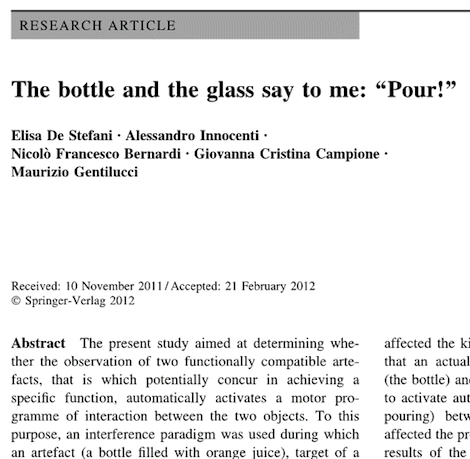Marc Abrahams's Blog, page 577
April 30, 2012
God-awful pollution of India’s waters
Do the gods pollute? Scientists in India, worried about the public health consequences of immersing idols in lakes and rivers, have been looking anew at water pollution. They hope, and perhaps in some cases pray, to harmonise their medical concerns with some people’s religious priorities.
Most of their research has focused on idols of the elephant-headed god Ganesh, created for the annual Ganesh Chaturthi celebration. Once a fairly quiet, mostly private practice, Ganesh Chaturthi now involves large, public festivals in many parts of the country. Researchers have also looked, a little, at the effects of immersing other idols, especially those of the many-armed goddess Durga.
One of the latest studies is called Assessment of the Effects of Municipal Sewage, Immersed Idols and Boating on the Heavy Metal and Other Elemental Pollution of Surface Water of the Eutrophic Hussainsagar Lake (Hyderabad, India)….
So begins this week’s Improbable Research column in The Guardian.
BONUS: The beginning of a lengthy 2010 Khairatabad TV news report about Ganesh idol immersion:
And a report from Hyderabad that same year:
BONUS: “Eco-friendly Ganesh idols ready for sale“

Hydration and Water Seem to Be Related
 A possible breakthrough in understanding the relation, if any, between hydration and water:
A possible breakthrough in understanding the relation, if any, between hydration and water:
“Hydration level is an internal variable for computing motivation to obtain water rewards in monkeys,” Takafumi Minamimoto, Hiroshi Yamada, Yukiko Hori and Tetsuya Suhara [pictured here], Experimental Brain Research, epub 2012.

April 29, 2012
Answering machine talk – under academic scrutiny
• What is ‘Answering Machine Talk’?
“Answering machine talk represents a form of mediated conversation in which messages are recorded to facilitate communication between participants.“
• What of the resources?
“The talk which occurs in such messages draws upon the pool of available resources for telephone-based communication…”
• What of the constraints?
“[telephone-based communication] … modifies these resources as the result of constraints imposed by the communicative environment.”
The quotes come from the paper : Discourse routines in answering machine communication in Australia (Discourse Processes, Volume 17, Issue 2, 1994) by , now Professor in Applied Linguistics, at the School of Communication, International Studies and Languages, of the University of South Australia.
We shouldn’t ignore an earlier paper : Answering machine talk (Discourse Processes, Volume 14, Issue 2, 1991, Ruby Gold) which had laid the important groundwork for the subject, explaining that:
“Answering machine talk appears to be a unique form of discourse employing elements of ‘performative’ spoken language, written language, and special uses of prosodic markers to create ‘dialogue’ with an absent interlocutor.”

April 28, 2012
Pour Experiment: More Subtle Than It Appears, Maybe
This pour experiment may shed light on the workings of one or several brains:
“The bottle and the glass say to me: ‘Pour!’” Elisa De Stefani, Alessandro Innocenti, Nicolò Francesco Bernardi, Giovanna Cristina Campione and Maurizio Gentilucci, Experimental Brain Research, epub 2012. The authors, at the University of Parma and the University of Milano-Bicocca, explain:
“the presence of the empty rather filled glass affected the kinematics of the actual grasp. This suggests that an actually functional compatibility between target (the bottle) and distractor (the empty glass) was necessary to activate automatically a programme of interaction (i.e. pouring) between the two artefacts.”

April 27, 2012
The epic endurance of nickel-a-bottle Coca-Cola
An economics paper explains, perhaps, the epic endurance of nickel-a-bottle Coca-Cola:
“‘The real thing’: nominal price rigidity of the nickel Coke, 1886-1959“, Daniel Levy and Andrew Young, Journal of Money, Credit and Banking, (2004). (Thanks to Sandeep Baliga for bringing this to our attention.) Levy and Young write:

We report that the price of a 6.5oz Coke was 5¢ from 1886 until 1959. Thus, we are documenting a nominal price rigidity that lasted more than 70 years! The case of Coca-Cola is particularly interesting because during the 70-year period there were substantial changes in the soft drink industry as well as two World Wars, the Great Depression, and numerous regulatory interventions and lawsuits, which led to substantial changes in the Coca-Cola market conditions. The nickel price of Coke, nevertheless, remained unchanged….
We offer a combination of three possible factors as an explanation for the Coca-Cola price rigidity. Two of these explanations are technology-based, while the third has to do with an unusual contract the Coca-Cola Company signed. First, we demonstrate that an installed base of vending machines with nickel-only capability, and the evolution of the technology that could accommodate multiple type coins and change making, imposed an important constraint on the ability of the Coca-Cola Company to adjust the Coke’s price. Second, at the 5¢ price per serving, the smallest price increase compatible with the consumer still using a single coin was a 100 percent jump to 10¢. A monetary transaction technology for smaller price adjustment while keeping consumer “inconvenience costs” low in terms of the number of coins needed for purchasing a bottle of Coca-Cola, was not available.

Advances in toilet system testing: Wigglers & Pseudo Poop
 Whither waste? Toilet testing, not everyone’s cup of tea, makes things flow better, for society’s sake. Metafilter features a little roundup of toilet testing info (thanks to investigator Scott Langill for bringing it to our attention):
Whither waste? Toilet testing, not everyone’s cup of tea, makes things flow better, for society’s sake. Metafilter features a little roundup of toilet testing info (thanks to investigator Scott Langill for bringing it to our attention):
Pseudo Poop for Testing ToiletsTesting toilet flush performance naturally requires the replication of real-world loads. Striving for accuracy, a Texas A&M study (PDF) evaluated polypropylene balls and Play-Doh sheathed in condoms before settling on a test payload of two Water Wigglers [a photo of one is reproduced here, at right] per flush. In contrast, the Maximum Performance project [one of their images is reproduced here, below] recommends the use of 350-gram specimens of extruded soybean paste (“specimens that float shall not be used”).

April 26, 2012
The Golfball Index (UPDATED: April 2012)
 See previous index for January, February, and March 2012.
See previous index for January, February, and March 2012.
The Golfball Index maintained its recent lacklustre performance during April 2012. As in the previous month, there were only 7 new US golfball patents.
• Thick inner cover multi-layer golf ball
• Three-layer-core golf ball having highly-neutralized polymer outer core layer
• Multi-piece golf ball comprising low hardness gradient core
• High performance golf ball having a reduced-distance
• Multi-layer core golf ball having opposing hardness gradient with steep gradient inner core layer
• Golf ball with negative hardness gradient core
Caution with regard to forward-looking statements: Historical data should not be taken as an indicator of future performance. The Golfball Index may go down as well as up.

Ignorance, risk, expertise, whatever
Ignorance, risk, rationality, expertise—this treatise has it all, plus food:
“Institutionalized ignorance as a precondition for rational risk expertise,” Henrik Merkelsen [pictured here], Risk Analysis, 2011 Jul;31(7):1083-94. The author, at Copenhagen Business School, explains:
“The present case study seeks to explain the conditions for experts’ rational risk perception by analyzing the institutional contexts that constitute a field of food safety expertise in Denmark… The article emphasizes the role of knowledge, responsibility, loyalty, and trust as risk-attenuation factors and concludes by suggesting that the preconditions for the expert’s rationality may rather be a lack of risk-specific knowledge due to poor risk reporting than a superior level of risk knowledge.”

Are Humans Hardwired for Feline Servitude?
Even if you’ve never lived with a cat, you can still be subject to their powers of mammalian mind-control.
“The Cry Embedded Within the Purr,” Karen McComb, Anna M. Taylor, Christian Wilson, and Benjamin D. Charlton, Current Biology, 19 (13), July 2009, pp. R507-8. DOI: 10.1016/j.cub.2009.05.033. The authors, from The Centre for Mammal Vocal Communication and Cognition Research and Zoo Atlanta, wrote in Current Biology:
“Here we report how domestic cats make subtle use of one of their most characteristic vocalisations — purring — to solicit food from their human hosts, apparently exploiting sensory biases that humans have for providing care. When humans were played purrs recorded while cats were actively seeking food at equal amplitude to purrs recorded in non-solicitation contexts, even individuals with no experience of owning cats judged the ‘solicitation’ purrs to be more urgent and less pleasant.”
Hear a
solicitation purr
versus a
non-solicitation purr
.

April 25, 2012
The risk of regulating risk, they write calculatingly….
Finance puzzles many people. This new study may make finance less puzzling, or more puzzling, or both:
“Any Regulation of Risk Increases Risk,” Philip Z. Maymin [pictured here] and Zakhar G. Maymin, arXiv:1004.1670v4, April 20, 2012. The first author identifies himself as Assistant Professor of Finance and Risk Engineering at NYU-Polytechnic Institute in Brooklyn, New York. The second author identifies himself as a former portfolio manager at “his own hedge fund” and as “the New York State chess co-champion and the Fairfield County (CT) open class chess champion”. The pair write:
“We show that any objective risk measurement algorithm mandated by central banks for regulated financial entities will result in more risk being taken on by those financial entities than would otherwise be the case”
(Thanks to investigator Elizabeth Chau for bringing it to our attention.)
BONUS: ”Schizophrenic Representative Investors,” Philip Z. Maymin, http://arxiv.org/abs/1004.4592, April 26, 2010.

Marc Abrahams's Blog
- Marc Abrahams's profile
- 14 followers

























